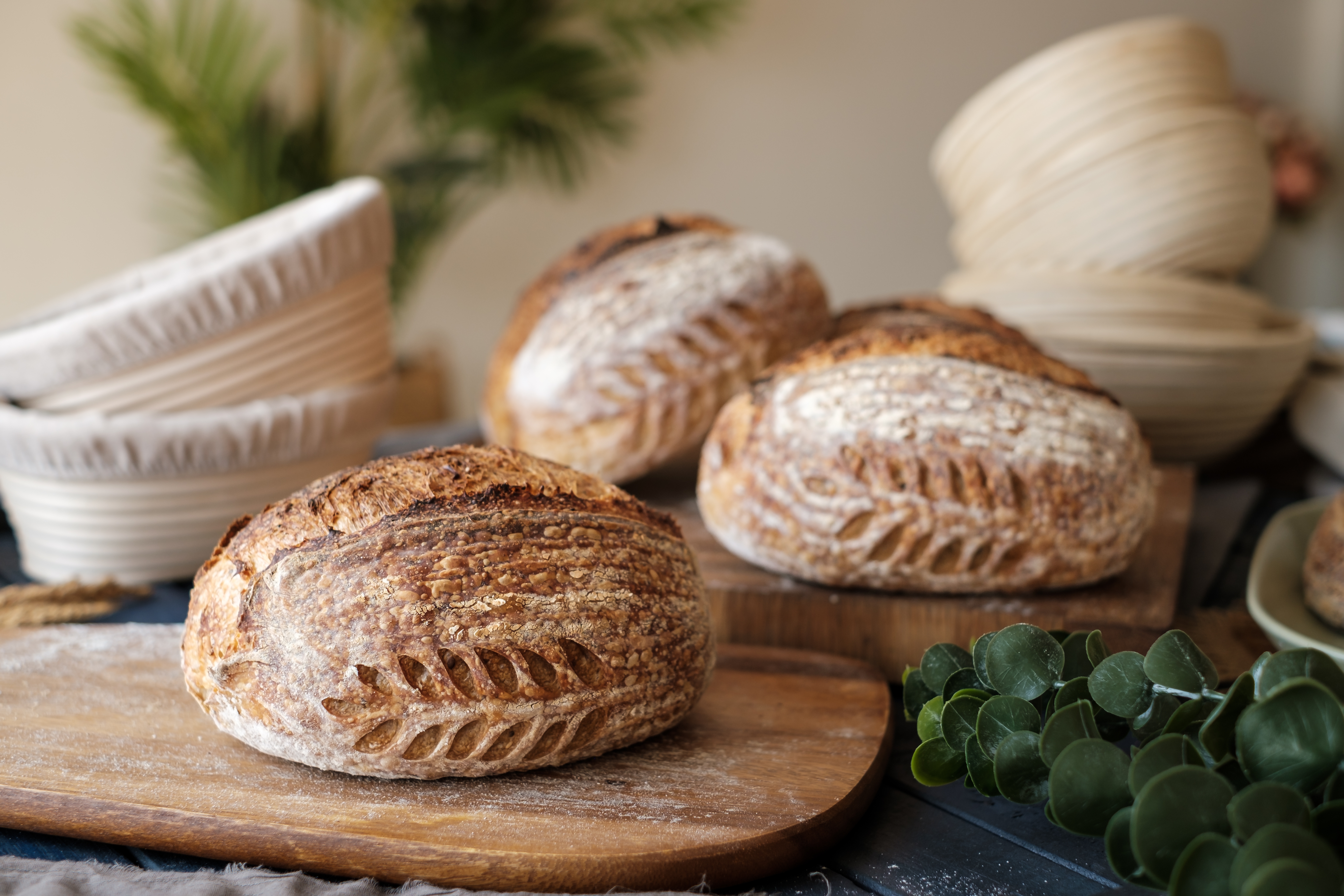A loaf of well-risen sourdough is the ultimate challenge for the home baker. For those of you who don’t know, sourdough is a loaf made without commercial yeast. Instead, it relies upon an active starter for a rise. This is a mix of flour and water that grows a colony of wild yeast and good bacteria as the fermentation process takes place. Sourdough has a tangy flavour as a result. You can make it with all different types of flour, from rye flour to wholemeal flour, but white bread flour is the most common.
How to make a sourdough starter
Day 1. Place 110g warm water and 100g all-purpose flour in a clean jar and stir until combined. Don’t use bleached flour (it’s had all the good bits stripped out). Mixing vigorously adds oxygen, which the wild yeast needs to grow. Cover the jar with a loose-fitting lid and leave in a warm spot for 24 hours.
Day 2, 8AM. Refresh the starter. Add 50g organic flour and 60g warm water to a new, clean container. Add 100g of the new starter. Discard the rest of the old starter, and wash the jar.
Day 2, 8PM. Repeat the feeding process. After a couple of feedings you should start to see signs of activity, like a few bubbles and a difference in smell. Daily feeding is very important for a healthy sourdough starter.
Days 3-6. Continue doing this twice a day for the next three to six days. You will know when your starter is ready; a healthy starter has plenty of bubbles and doubles in size within five hours of being refreshed. This means the wild yeast is very active. Make sure your starter is refreshed at least 12 hours before you start baking your loaf. And be aware that the process will be slower in colder temperatures!
Recipe for a Sourdough Boule bread
Ingredients
380g water at 27°C
150g healthy starter
400g organic white wheat flour (13% protein), plus extra for dusting
100g organic stoneground wholegrain wheat flour (11.5% protein)
10g fine sea salt
2 tbsp polenta
Method
1. Before you mix your dough, you will need to refresh your starter twice. When it has plenty of bubbles it’s ready to be worked with.
2. The second step is to mix your dough. Use your kitchen scale to measure out 350g of the water and the starter. In the bowl of a stand mixer, whisk together 350g of the water and the sourdough starter until well combined. Tap water is fine, unless your water is very over-treated with chlorine. Add the flours and sprinkle the salt evenly over the top. Mix vigorously in the stand mixer with the dough hook for about two minutes until there is no dry flour left and the mixture comes together to form a stiff ball. This initial mix can feel quite tight, but by not adding all the water yet we ensure the gluten develops well.
3. Cover with a clean kitchen towel or plastic wrap and let the dough rest for one hour so the gluten can form. Meanwhile, refresh the remaining starter in your jar and put to one side.
4. The next morning, preheat your oven to 220°C/ Fan 220°C/ Gas 7 for 30 minutes and place a cloche in the oven to preheat.
5. Taking great care, remove the hot cloche from the oven and put the dome to one side. Scatter the polenta over the base of the cloche – it will act like tiny marbles to stop the dough sticking. Turn the dough out onto the hot cloche base, removing the banneton gently. Score the dough using a lame and cover immediately with the cloche dome.
6. Place in the oven and reduce the temperature to 200°C/ Fan 180°C/Gas 6. Bake for 50 minutes. After this time, remove the lid of the cloche and bake for a further one to seven minutes, depending on how dark you like your crust. All ovens are different, so be sure to check your loaf towards the end of the baking time.
7. Carefully remove the cloche from the oven and cool your loaf on a wire rack. Alternatively, you leave the bread in the oven with the door open as it cools – this will give you a really crusty, beautiful loaf.
8. Once cool, wrap your loaf in a clean, dry tea towel for storage. Best enjoyed within three days.
Sourdough baking tips
My starter smells like nail polish remover - what does that mean?
This probably means it’s feeding time! Give it some flour; in a few hours it should start smelling fresh and yeasty.
My starter smells like feet!
If it’s new, it might be going through enzyme changes. Keep feeding and monitoring it. If the starter begins to smell milky/cheesy then congratulations - it sounds like it has a culture of lactic acid! If it’s just super tangy, then you might have a mature starter; and you’ll end up with lovely sour bread.
My starter isn’t doing anything
Look more closely at the type of flour you’re using. Bleached flour hasn’t got any natural enzymes in, which your starter needs. It could also be your tap water - heavily chlorinated water might be killing the culture. Try using bottled water instead. The most likely solution, however, is that it isn’t warm enough; seek out a warm spot like the airing cupboard, or above a radiator.
My starter contains brown liquid
It’s a type of alcohol product, and a byproduct of fermentation. It means the starter is ready to be fed! Discard or stir in the alcohol, and carry on.


